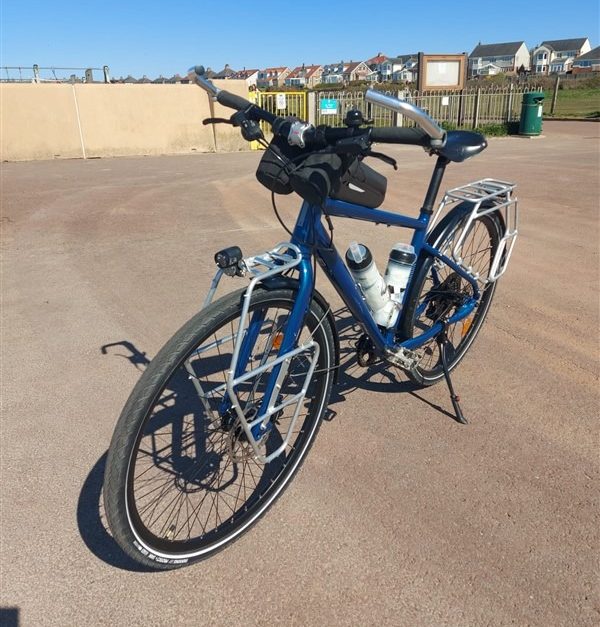Long distance cycling is more than a hobby—it’s a journey, a challenge, and a gateway to adventure, fitness, and freedom. Whether you’re planning a weekend touring trip, diving into bikepacking, or simply want to stretch your daily ride further, getting started with long distance cycling can seem overwhelming at first. This beginner’s guide will walk you through everything you need to know—from gear and training to mindset and motivation.
What Is Long Distance Cycling?
Long distance cycling refers to any ride that goes well beyond everyday commuting or casual riding. For many, it starts around the 100 km (62-mile) mark, but it can span hundreds or even thousands of kilometres across multiple days.
What counts as “long distance” varies depending on experience. It includes multi-day bike tours, randonneuring events, gravel expeditions, and ultra-endurance races. The common thread? A sense of self-reliance, stamina, and the spirit of exploration.
Benefits of Long Distance Cycling
Before diving into the how-to, here’s why so many cyclists are drawn to the open road:
- Improved fitness: Builds cardiovascular strength and endurance.
- Mental clarity: Long rides are a meditative escape from daily stress.
- Adventure: Explore new places, from scenic coastlines to remote mountain passes.
- Simplicity: All you need is a bike, basic gear, and a sense of direction.
- Community: Join like-minded adventurers around the world.
How to Prepare for Long Distance Cycling
Set Realistic Goals
Starting small is crucial. Your first “long” ride might be 30 or 50 km. Focus on distance or time in the saddle—whatever motivates you. As you gain confidence, gradually increase your mileage.
Choose the Right Bike
Your bike doesn’t need to be top-of-the-line, but it must be reliable and suited for distance. Common options include:
| Bike Type | Best For | Notes |
|---|---|---|
| Touring Bike | Paved roads, heavy loads | Built for comfort and cargo |
| Gravel Bike | Mixed terrain, light packing | Versatile, with wider tire clearance |
| Road Endurance Bike | Speed on tarmac, long distances | Lighter but less cargo capacity |
| Mountain Bike (MTB) | Rugged trails, bikepacking | Ideal for off-road routes |
Bike Fit and Comfort
A proper bike fit is non-negotiable. Long rides amplify discomfort, so getting your saddle height, reach, and handlebar setup dialled in is essential. Consider a professional bike fitting service, or use online guides if you’re on a budget.
Essential Gear Checklist
Equipping yourself with the right gear is half the battle. Here’s what beginners should consider:
Clothing and Accessories
- Padded cycling shorts (your best friend!)
- Moisture-wicking jersey
- Lightweight windproof jacket
- Gloves, cycling cap, and sunglasses
On-Bike Essentials
- Spare tubes or patch kit
- Mini pump or CO₂ inflator
- Multi-tool with chain breaker
- Tyre levers
- Water bottles or hydration pack
Navigation and Safety
- Front and rear lights (even during the day)
- GPS unit or smartphone with cycling app
- Bell and reflectors
- Emergency contact card or ID
Luggage Solutions
For longer rides or overnight tours, invest in:
- Saddlebag
- Handlebar bag
- Frame bag or panniers (for touring)
Start light—only bring what you’ll actually use.
Training for Long Distance Cycling
Build Endurance Gradually
Don’t jump into a 100 km ride overnight. Use the 10% rule: increase your weekly distance by no more than 10% to avoid overuse injuries and burnout. Mix in rest days and recovery rides.
Focus on Cadence and Pacing
Pedalling efficiently means maintaining a steady cadence (around 80–90 RPM). Don’t hammer the pedals; ride at a sustainable pace, especially when tackling hills or rough surfaces.
Nutrition and Hydration
Long rides require fuel. Practice eating on the bike using energy bars, dried fruit, or peanut butter sandwiches. Drink regularly—even before you feel thirsty. A good rule: one bottle per hour.
Planning Your First Long Ride
Pick a Beginner-Friendly Route
Choose a route with:
- Safe cycling infrastructure or low-traffic roads
- Loops or out-and-back routes near civilization
- Rest stops, cafés, or refill points along the way
Use apps like Komoot, RideWithGPS, or Strava to map your ride and download offline directions.
Check the Weather
Wind and rain can turn a dream ride into a struggle. Always check conditions before heading out, and dress in layers you can add or remove as needed.
Ride with a Friend (Optional)
Riding with a buddy is a great way to stay motivated and safe. If solo, let someone know your route and ETA.
Common Challenges—and How to Beat Them
Saddle Soreness
Invest in a quality saddle and cycling shorts. Use chamois cream and stand occasionally to relieve pressure.
Fatigue
Listen to your body. Rest days are as important as training days. Sleep well, and fuel consistently on the ride.
Navigation Issues
Practice route planning and get familiar with your GPS or cycling app in advance. Always have a backup route.
Mechanical Problems
Learn to fix a flat, adjust gears, and deal with minor mechanicals. Practice at home first—it builds confidence.
Connecting with the Long Distance Cycling Community
Long distance cycling is as much about the people as the pedaling. Here’s how to meet others:
Join Online Forums & Groups
- Comment on this article or share your long distance cycling experiences in our comment section below and connect with other endurance riders worldwide.
Attend Local Events
- Brevets (randonneuring)
- Sportives or gran fondos
- Bikepacking overnighters or group rides
Follow Blogs & Newsletters
Many cyclists share gear tips, routes, and stories online. Subscribing to newsletters is a great way to stay informed and inspired.
Long Distance Cycling Tips for Beginners
- Ride your own ride: Go at your own pace; you’re not racing.
- Test your gear before long trips: Even a short overnight trip can reveal gear flaws.
- Enjoy the journey: Take breaks. Snap photos. Talk to locals.
- Stay visible: Use lights and wear high-visibility clothing when needed.
- Be flexible: Weather, traffic, or mechanical issues may force a change in plans.
Final Thoughts
Long distance cycling is one of the most rewarding ways to explore the world, test your limits, and connect with others. Starting out might feel daunting, but with the right preparation, mindset, and gear, you’ll be surprised how far you can go.
Whether you’re pedalling through city streets, forest trails, or mountain passes, every kilometre brings new experiences and memories.
Call to Action
Ready to start your journey?
🔹 Sign up for our monthly newsletter to get expert tips, route ideas, and exclusive gear deals
Know someone who’s thinking about cycling longer distances? Share this guide and help them get rolling!










